"Going Nuts"
November 5, 2009 - Volume 1 - Issue 21
|
|
|
|
|
|
Just a Little Nutty...
|
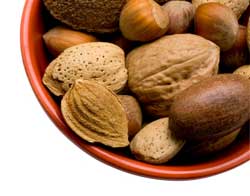 "Going
nuts" most commonly refers to a momentary mental state, but today we
take it literally with our exploration of nuts as great food. Fresh
crops are being harvested in abundance right now by people and
squirrels alike. We all have our favorite nut preparations - pine nuts
in pesto, macadamia nuts in white chocolate chip cookies, or, perhaps,
simple beer nuts with a cold brew. Nuts are always an appropriate party
food as well as a great nutritional snack. Get ready for the season
ahead with easy nut recipes that will be a hit in your home, or in
festooned packages delivered to friends. In this issue, you'll get
better acquainted with some common culinary nuts and some key nut
preparation techniques. We conclude with three recipes featured from
the cookbook, Party Nuts, that will set you up for some extraordinary
enjoyment of nuts prepared in many different, delicious ways. "Going
nuts" most commonly refers to a momentary mental state, but today we
take it literally with our exploration of nuts as great food. Fresh
crops are being harvested in abundance right now by people and
squirrels alike. We all have our favorite nut preparations - pine nuts
in pesto, macadamia nuts in white chocolate chip cookies, or, perhaps,
simple beer nuts with a cold brew. Nuts are always an appropriate party
food as well as a great nutritional snack. Get ready for the season
ahead with easy nut recipes that will be a hit in your home, or in
festooned packages delivered to friends. In this issue, you'll get
better acquainted with some common culinary nuts and some key nut
preparation techniques. We conclude with three recipes featured from
the cookbook, Party Nuts, that will set you up for some extraordinary
enjoyment of nuts prepared in many different, delicious ways.
|
Upcoming Events!
|

|
|
|
|
Upcoming Events!
|
November
is
Cutlery Month
Each Saturday in November and the week following, we will feature one of our premier brands of cutlery and offer some great pre-holiday promotions. |
 |
Nov 7 - Henckels 8-piece Block Set, Twin Forged Four Star, $149.99, (Regularly $299.99) |
Nov 14 - Wusthof 3.5" Classic Paring Knife $29.99 reg $67.00 & the new Classic Wave Slicer, 7" $99.99 (Regularly $125). |
Nov 21 - Messermeister! Chelsea Dressler, our Messermeister representative will be in the store from 10-1 to sharpen any 2 knives free of charge, answer any cutlery questions and help you make your holiday selections. Meridian Elite 7" Hollowed Ground Santoku $79.99 with free shears with purchase. (Regularly $132). |
Nov 28 - Shun Ken Onion 7 Piece Essential Block Set $729.99 with free Ken Onion Carving Set $299.99 value. |
|
|---|
|
In a Nutshell...
|
Strictly speaking, a nut is
the seed of a tree's fruit - the tree's best hope for passing on its genes to
the next generation. The kernel is usually surrounded by a sturdy, protective
shell that frequently challenges our access to the treasure inside!
Nuts
get an ok from nutritionists for many reasons. They have a 50-60% fat content,
but mostly the good kind, monounsaturated, and naturally free of cholesterol.
They are high in protein, fiber, and an important source of B vitamins, Vitamin
E, magnesium, and copper. Nutritionally dense, the key to enjoying nuts is
moderation.
Appreciate each type of nut for what it is and the distinct
flavors each one offers. Not really tree nuts, but treated like a nut in the
kitchen, we've included peanuts, pumpkin seeds, and sesame seeds in our
review.
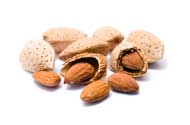
Almonds Related to peach
and plum trees, almonds are one of the most popular culinary nuts. Sweet almonds
are used for eating in all their forms, while bitter almonds are used for almond
oil and liqueur flavorings. We understand that a stroll through a blooming
almond orchard is enchanting. |
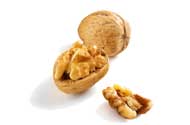
Walnuts Broadly used in
many cuisines in various forms, walnuts are commonly available as English
Walnuts or Black Walnuts. Rich in manganese and copper, walnuts rate a "Heart
Healthy®" designation when eaten in moderation.
|
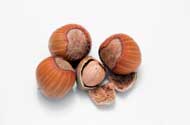
Hazelnuts/Filbert
From very similar
trees, these two nuts are used interchangeably. Hazelnuts are very popular in
European pastries and confections. Oregon is the only domestic source of these
nuts. Hazelnuts are rich in thiamine and Vitamin B6.
|
|
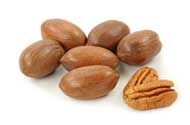
Pecans
Pecans are the
only tree nut originating in North America and come from a specific species of
hickory tree. They are native to the Midwest and South. Pecans rate in many
American regional dishes while providing a great dose of manganese and favorable
omega-6 fatty acids.
|

Brazil
Nut
An Amazon rain
forest nut, 20+ nuts reside in their own shell inside a larger coconut-like pod.
Grown by centuries-old, tall trees, the flower is pollinated by a specific
species of bee. The large nut is rich with a creamy texture and high in
magnesium and selenium.
|
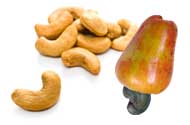
Cashews
Indigenous to
Brazil, the cashew now grows in similar tropical regions. The seed resides
singly in a shell and dangles as an appendage to a rather large fruit. Cashews
are a popular snack nut and common in Asian cuisines.
|
|
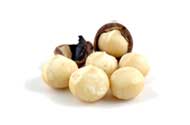
Macadamias
Originating in
Australia and now native to the South Pacific region, macadamias possess one of
the highest fat contents among nuts -- up to 75%. Macadamias, salted and
roasted, are a popular snack and have a natural affinity to
chocolate.
|
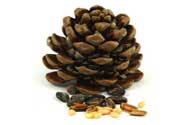
Pine
Nuts
Tucked into pine
cones of several pine tree species are tiny, succulent pine nuts. Once shelled,
the pine nuts' oils deteriorate quickly and become rancid. Also known as pignoli
nuts, pine nuts are an equal partner in pestos, used as a pastry garnish, and
featured in many distinctive dishes.
|
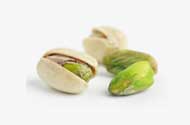
Pistachios
Native to the mountainous
areas of the Near East, pistachios have a long culinary history (baklava,
spumoni . . .). The nut is green in color and has a naturally open shell when
mature that allows it to be roasted and salted without shelling. Pistachios have
a "Heart Healthy®" designation - in moderation.
|
|
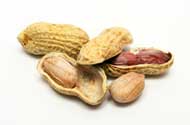
Peanuts
Really a legume,
peanuts are seeds retrieved from a pod like other beans. Huge quantities of this
nut are consumed every year. China produces 37% of the peanut crop followed by
India, Nigeria, and then the U.S.
|
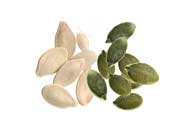
Pumpkin
Seeds
Known also as pepitas, the
seeds are easily harvested from our favorite fall squash and pack a nutritional
punch. Pepitas are a popular ingredient in Mexican cooking.
|
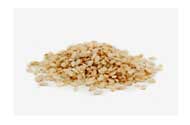
Sesame
Seeds
Really a grain
seed, sesame seeds are handled much like a nut in the kitchen. Sesame plants
thrive in tropical regions and flourish in Middle Eastern cuisines. Sesame oil
is indispensible in Far Eastern kitchens. | |
|
Roasty, Toasty Nuts
|
Why
roast nuts? If you're eating nuts out of hand, roasting is an essential
step for bringing out their flavor. Roasting nuts make a nut
"nuttier!" The difference is remarkable. You might rationalize that
the nuts are going to bake anyway; not roasting will save some time.
Well, it's not the same thing. If you want flavor, and that's what it's
all about, take the extra step to roast or toast nuts prior to adding
them to your recipe.
Choosing Nuts
- Choose your nuts from a respected source or buy a reputable brand. The
high fat content of nuts means that they are susceptible to oil
rancidity. Oils that have become rancid will not hurt you, in general,
but do have a greater quantity of free radicals which may be harmful.
Eventually, rancid oils will not smell or taste good. Choose your nuts
from an inventory that has a frequent turnover.
 Storing Raw Nuts
- Store raw nuts in the refrigerator or freezer in an airtight
container for up to a year. Nuts purchased in tightly closed shells may
be kept at cool room temperatures for up to a year. Raw nuts are
certainly fine, but many have developed a dislike of nuts because
they've experienced nuts in their raw form instead of toasted. Storing Raw Nuts
- Store raw nuts in the refrigerator or freezer in an airtight
container for up to a year. Nuts purchased in tightly closed shells may
be kept at cool room temperatures for up to a year. Raw nuts are
certainly fine, but many have developed a dislike of nuts because
they've experienced nuts in their raw form instead of toasted.
Roast
nuts in one of two ways, dry roasting or wet roasting. With either
method, a low temperature and 10-20 minutes of careful oversight will
yield the best results. The higher the fat content of the nut, the
faster the roasting will occur.
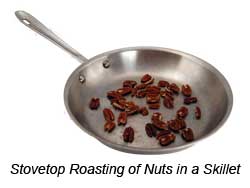 Oven Roasting
- This method of roasting uses low oven temperatures (180°F - 250°F)
over a period of time ranging from 10-20 minutes depending on the nut.
To dry roast, place the nuts on a sheet pan in a single layer in the
warm oven. Stir the nuts every 10 minutes. The nuts are roasted when
their color has deepened several shades and the kitchen is pleasantly
fragrant. To wet roast, drizzle a small amount of oil over raw nuts in
a bowl and toss until evenly coated and proceed similarly. The oil will
add additional flavor, but also adds additional calories and oily
handling. Oven Roasting
- This method of roasting uses low oven temperatures (180°F - 250°F)
over a period of time ranging from 10-20 minutes depending on the nut.
To dry roast, place the nuts on a sheet pan in a single layer in the
warm oven. Stir the nuts every 10 minutes. The nuts are roasted when
their color has deepened several shades and the kitchen is pleasantly
fragrant. To wet roast, drizzle a small amount of oil over raw nuts in
a bowl and toss until evenly coated and proceed similarly. The oil will
add additional flavor, but also adds additional calories and oily
handling.
Stovetop Roasting
- Nuts may be roasted, wet or dry, in a skillet on the stovetop. Use
medium-low heat, with or without oil, and focused attention. Nuts with
their high fat content burn easily. Stir the nuts regularly during the
roasting process. Using a skillet or pan that has sloped sides will
facilitate a frequent quick toss. The nuts are just right when slightly
browned and deliciously fragrant.
Removing the Skins
- Many shelled nuts have a paper-thin skin encasing the meaty nut
inside. The brown skin is perfectly edible, but may be bitter in some
nuts such as hazelnuts. 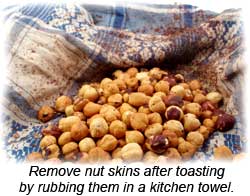 To remove the skins of hazelnuts, for example, dry oven roast the nuts
in a single layer. When golden and fragrant, remove from the oven and
cool slightly. Transfer the nuts to a kitchen towel and rub the nuts
together. The toasted skins will peel away with the commotion and leave
a golden, sweet nut behind.
To remove the skins of hazelnuts, for example, dry oven roast the nuts
in a single layer. When golden and fragrant, remove from the oven and
cool slightly. Transfer the nuts to a kitchen towel and rub the nuts
together. The toasted skins will peel away with the commotion and leave
a golden, sweet nut behind.
Storing Roasted Nuts
- Just as with raw nuts, store toasted nuts in an airtight container in
the refrigerator or freezer. Toasted nuts can be freshened with a light
warming in the oven or in a skillet. However, freshly roasted nuts are
preferable to stored roasted nuts.
|
Right-Sizing Nuts
|
Roasty
and toasty, the nuts are ready to enjoy out of hand, embellished or as
a key ingredient in favorite recipes. Depending on the intended use,
nuts may need to be cut down to size. (Always roast the nuts whole
prior to chopping).
 Whole Nuts
- These are the perfect, bite-sized snack food at a party, public or
private. Spiced and/or glazed nuts are the perfect do-ahead dish,
simple, delicious and satisfying. Enjoy a single type of nut, or mix
several types of nuts for a complementary mix. (See the three recipes
below). Use whole nuts as a garnish Whole Nuts
- These are the perfect, bite-sized snack food at a party, public or
private. Spiced and/or glazed nuts are the perfect do-ahead dish,
simple, delicious and satisfying. Enjoy a single type of nut, or mix
several types of nuts for a complementary mix. (See the three recipes
below). Use whole nuts as a garnish
 Chunks
- Use a sharp chef's knife to cut whole nuts into large chunks. We find
it helpful to position the cutting board in a corner location where any
ricocheting nuts can be easily corralled. Chunks
- Use a sharp chef's knife to cut whole nuts into large chunks. We find
it helpful to position the cutting board in a corner location where any
ricocheting nuts can be easily corralled.
Coarse to Fine Chop
- Nut pieces, large or small, can be had with a knife and cutting
board, a manual chopper, or a food processor. Manual choppers use
multiple blades in a confined area - the longer the chop, the smaller
the result. A food processor is also perfect for accomplishing a coarse
chop or a fine grind. Use the "pulse" function on 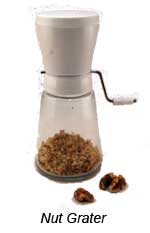 the
processor to manage your nuts to just the right size. Processing
happens quickly with nuts, so use a light hand in pulsing, evaluating
the result often. the
processor to manage your nuts to just the right size. Processing
happens quickly with nuts, so use a light hand in pulsing, evaluating
the result often.
Nut Meal
- Many baking recipes substitute finely ground nuts, (nut meal),
instead of flour. A nut grinder or a food processor is essential for
making consistently sized nut meal. Take care as you process nuts into
nut meal, it may turn into nut butter more quickly than you think!
Nut Butters
- Nuts ground into a smooth texture are favorite preparations. Peanut
butter sandwiches are the most common sandwich in the U.S. A gourmet
alternative to PB is almond butter or cashew butter. Nut butters can be
made in a food processor by processing toasted nuts until a  smooth
paste is formed. Nut butters, homemade or commercially prepared, may be
stored in the cupboard for three months, or in the refrigerator or
freezer for up to a year. Oils may separate in the butter as the nut
butter stands; simply stir or process back into the butter. (Commercial
peanut butter does not separate because of the addition of hydrogenated
oils). smooth
paste is formed. Nut butters, homemade or commercially prepared, may be
stored in the cupboard for three months, or in the refrigerator or
freezer for up to a year. Oils may separate in the butter as the nut
butter stands; simply stir or process back into the butter. (Commercial
peanut butter does not separate because of the addition of hydrogenated
oils).
Nut Pastes -
Sweetened nut butters offer additional uses in the kitchen - almonds
become marzipan; chestnut paste, sweetened or unsweetened, becomes a
key ingredient in many seasonal dishes.
Nut Oils and Extracts
- As half the content of a nut, extracted nut oils are a natural -
peanut, walnut, and pecan are a few of the more common oils that lend
their strength and flavor to cooks everywhere. Nut oils and extracts
are great flavorings for coffee and a plethora of pastries.
|
Smart Nut Tips
|
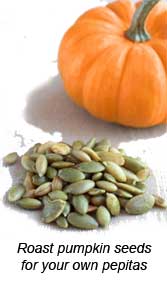 Tip #1:
As you make use of the season's pumpkins, harvest the seeds for a
delightful treat. Wash the seeds in a water bath removing any pumpkin
flesh or strings by rubbing the seeds between your hands. Strain and
let dry. For every two cups of seeds, toss with 2 tablespoons of oil
and 1 teaspoon of salt. Roast the seeds in a single layer on a baking
pan in an oven set at 275°F for 10-20 minutes or until barely browned. Tip #1:
As you make use of the season's pumpkins, harvest the seeds for a
delightful treat. Wash the seeds in a water bath removing any pumpkin
flesh or strings by rubbing the seeds between your hands. Strain and
let dry. For every two cups of seeds, toss with 2 tablespoons of oil
and 1 teaspoon of salt. Roast the seeds in a single layer on a baking
pan in an oven set at 275°F for 10-20 minutes or until barely browned.
Tip #2:
Package a modest serving of nuts in individual portions. Grab a bag of
your special nuts in the morning and throw it in your lunch bag or
briefcase. When the 11:00am hunger pangs hit, or the 4:00pm cravings
mount, you'll have a nutritious, satisfying answer. The trick is
pre-packaging modest portions!
Tip #3:
Experiment with different species of nuts. One of our favorite variants
is the Missouri Pecan. It is a small, petite variation of larger
pecans. We like them because they crowd nicely in our pecan pies.
Tip #4:
Enjoy a classic autumn sandwich featuring walnuts on top of an
open-faced sandwich. Begin with a slice of whole-grained bread, layer a
few slices of smoked turkey deli meat followed by thin slices of a tart
apple. Top with provolone cheese, then walnut halves. Broil carefully until the cheese  melts and the nuts become lightly browned. melts and the nuts become lightly browned.
Tip #5: Freshly harvested nuts
are a treat! Shelling them yourself also slows down the speed of
intake if that is a factor for you. A bowl of nuts in the shell make
for a beautiful presentation on a side table or on the kitchen counter.
Equip your guests with nutcrackers, nut picks, and a bowl for shells.
Each nut's shell has a fault line where the nut will crack easily under
force; some experimentation will get you acquainted with each nut's
anatomy and vulnerable point.
|
Q & A's
|

Q: What are nut allergies? What is proper nut etiquette with regard to nut allergies?
A:
Nut allergies are the body's natural response to what it perceives as a
foreign, invading substance. The body mounts its defenses with a
cascading histamine response which can result in a serious situation.
About 1% of the American population has some sort of nut allergy.
Peanuts, while not nuts, can produce an allergic reaction. Individuals
may have allergies to either peanuts or tree nuts, or both. Advise your
guests which foods contain nuts.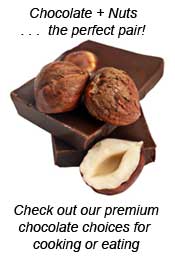
Q: What is gianduja?
A:
Gianduja is a mixture of chocolate and hazelnuts. Originating in the
Piedmont region of Italy, the name stems from a carnival character
representing that region. Similarly, Nutella® is a smooth spread made
of hazelnuts, skim milk and chocolate. It, too, hails from the Piedmont
region of Italy. Mr. Pietro Ferrero introduced the hazelnut paste as a
filler to his chocolate spread during WWII when chocolate was rationed
and in short supply. The temporary solution became a beloved tradition
everywhere. Try it on toast!
Q: What is oil rancidity?
A:
As oils sit at room temperature they begin to break down. The chemical
degeneration produces free radicals, charged molecule parts not
connected to other molecular parts of the substance. This chemical
demise results in rancidity. Oil may be rancid before its demise
becomes detectable by taste or smell. Store oils away from sunlight.
Refrigerating oils will slow down the degenerative process of oil
rancidity.
Q: Why were pistachios frequently dyed red in the past?
A:
The shells of pistachios are porous, fibrous and susceptible to
staining. The red dye was used to mask any stains that occurred from
handpicking. Most pistachios are now machine picked and staining is not a
problem. Pistachio shells naturally crack open when ripe, (some call it
"smiling"), allowing them to be roasted and salted without shelling.
The cracked shell gives rise to its nickname as the "Happy Nut."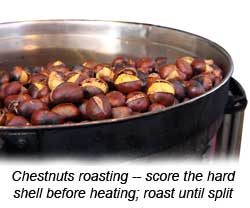
Q: How do you roast chestnuts?
A:
Romanticized in song, real "chestnuts roasting o'er an open fire" are
possible. They may also be roasted in an oven. First of all, choose
edible chestnuts, (not every chestnut tree produces edible chestnuts).
Score a small "x" in each chestnut with a sharp knife; this will allow
steam to escape when heated. Place in a baking dish in a single layer
with the "x" side up. Place in a hot oven (425°F) for 20-30 minutes.
When the skins split and the nut is becoming golden, remove from the
oven and peel while still warm.
|
|
Cookbook Review
|
Party Nuts by Sally Sampson. Photography by Duane Winfield. Published by Harvard Common Press, Boston, MA. Copyright 2002.
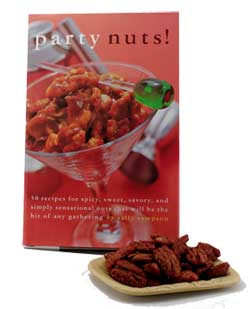 This
single-subject book is one of those little gems that will be referred
to again and again for inspiration and instruction. The author is
self-described as "a bit nuts" over nuts, and her passion and expertise
show through in each recipe. The book categorizes its offerings into
some general categories: Savory Nuts, Hot Nuts and Sweet Nuts. She
finishes her compendium of nut mixes with two follow-on recipes, one
for toffee and one for brittle using any number of the previous recipes
for a delightful kick to these classic confections. Each recipe
includes an annotation regarding what else could be done with the
specific recipe, i.e., use on salads, or in muffins, etc., or a
suggestion of what beverage would best complement the dressed up nuts.
The sumptuous photography provides great visual inspiration. The author
certainly achieves her goal of dishing up dozens of delicious party
nuts -- all for our daily enjoyment! This
single-subject book is one of those little gems that will be referred
to again and again for inspiration and instruction. The author is
self-described as "a bit nuts" over nuts, and her passion and expertise
show through in each recipe. The book categorizes its offerings into
some general categories: Savory Nuts, Hot Nuts and Sweet Nuts. She
finishes her compendium of nut mixes with two follow-on recipes, one
for toffee and one for brittle using any number of the previous recipes
for a delightful kick to these classic confections. Each recipe
includes an annotation regarding what else could be done with the
specific recipe, i.e., use on salads, or in muffins, etc., or a
suggestion of what beverage would best complement the dressed up nuts.
The sumptuous photography provides great visual inspiration. The author
certainly achieves her goal of dishing up dozens of delicious party
nuts -- all for our daily enjoyment!
|
|
Recipes for Party Nuts
|
Recipes excerpted from Party Nuts!
by Sally Sampson. Photography by Duane Winfield. Published by Harvard
Common Press, Boston, MA. Copyright 2002. Reprinted with permission of
the publisher. All rights reserved.
Hot Cayenne Tabasco Almonds
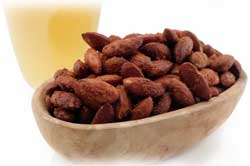 These
nuts live up to their billing of "too good to stop!" Paired, as the
author suggested, with a cold beer, we found life pretty sweet for a
while! Coming from two sources, the heat had both a front burn and an
after burn that made these nuts a complete experience. The Tabasco's
vinegar component was subtle, but just enough to start salivating with
the first bite. These nuts were the first to go during our living room
tailgating party! These
nuts live up to their billing of "too good to stop!" Paired, as the
author suggested, with a cold beer, we found life pretty sweet for a
while! Coming from two sources, the heat had both a front burn and an
after burn that made these nuts a complete experience. The Tabasco's
vinegar component was subtle, but just enough to start salivating with
the first bite. These nuts were the first to go during our living room
tailgating party!
Click here to view the full, illustrated recipe.
Click here for a printable version of the recipe (PDF format).
Roasted Southern Pecans Sweet and Piquant
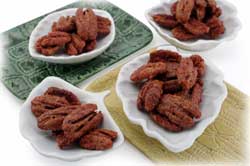 Can't
decide if you want a savory flavor or a sweet taste? No need to choose
with this recipe. These pecans are treated to a covering of both sweet
and savory with the help of a whipped egg white medium. The egg white
helps to bind the flavorings to the nuts and forms a gentle crust that
adds to the appetizing, crunchy experience. Can't
decide if you want a savory flavor or a sweet taste? No need to choose
with this recipe. These pecans are treated to a covering of both sweet
and savory with the help of a whipped egg white medium. The egg white
helps to bind the flavorings to the nuts and forms a gentle crust that
adds to the appetizing, crunchy experience.
Click here to view the full, illustrated recipe.
Click here for a printable version of the recipe (PDF format).
Holy Mole Pecans
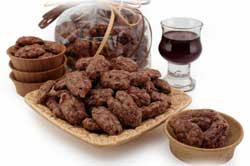 True
to their name, this nut recipe combines three familiar flavors into a
classic mole blend. This nut mix begs for a living room fire, a warm
toddy of some sort, and some good company. The blend was neither too
spicy, nor too sweet, but just right! We made a double batch, ate one
rather quickly, and used the other batch coarsely chopped in a batch of
shortbread cookies. Divine results! True
to their name, this nut recipe combines three familiar flavors into a
classic mole blend. This nut mix begs for a living room fire, a warm
toddy of some sort, and some good company. The blend was neither too
spicy, nor too sweet, but just right! We made a double batch, ate one
rather quickly, and used the other batch coarsely chopped in a batch of
shortbread cookies. Divine results!
Click here to view the full, illustrated recipe.
Click here for a printable version of the recipe (PDF format).
|
 |
Make going nuts a positive thing!
|
|
Lorraine, Katie, and all of the Staff at Beyond Pots and Pans
|
|
|
|
|